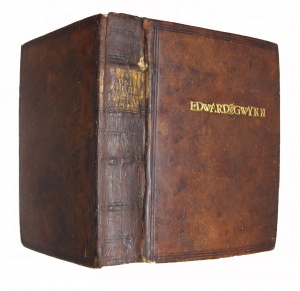Edward Gwynn copy of the Pavier quartos
The Edward Gwynn copy of the Pavier quartos is special for still being in its original 17th-century binding, stamped with the name of its original owner, Edward Gwynn.[1] Henry Folger prized it highly, and is shown holding it in the portrait painted by Frank Salisbury.
The volume is shelved as STC 26101 copy 3 because the first title in it is the Folger's third copy of STC 26101, The Whole Contention Between the Two Famous Houses, Lancaster and York...Divided into Two Parts (a combination of Henry VI, Part 2 and Henry VI, Part 3) followed by Pericles (with a separate title page, but continuous register).
The plays in the Gwynn copy are bound as follows:
- Henry VI, Part 2 and Henry VI, Part 3 as The Whole Contention Between the Two Famous Houses, Lancaster and York...Divided into Two Parts (that is, STC 26101 through leaf Q4): Folger call number STC 26101 copy 3 (Hamnet record)
- A Midsummer Night's Dream: Folger call number STC 22303 copy 5 Bd.w. STC 26101 copy 3 (Hamnet record)
- Sir John Oldcastle: Folger call number STC 18796 copy 4 Bd.w. STC 26101 copy 3 (Hamnet record)
- The Merchant of Venice: Folger call number STC 22297 copy 3 Bd.w. STC 26101 copy 3 (Hamnet record)
- Henry V: Folger call number STC 22291 copy 4 Bd.w. STC 26101 copy 3 (Hamnet record)
- King Lear: Folger call number STC 22293 copy 5 Bd.w. STC 26101 copy 3 (Hamnet record)
- Pericles (that is, the remaining leaves of STC 26101): Folger call number STC 26101 copy 3 (Hamnet record)
- The Merry Wives of Windsor: Folger call number STC 22300 copy 4 Bd.w. STC 26101 copy 3 (Hamnet record)
- A Yorkshire Tragedy: Folger call number STC 22341 copy 4 Bd.w. STC 26101 copy 3 (Hamnet record)
Notes
- ↑ For many years, it was thought that it was the only extant set that had not been rebound or disbound, but at least two others are now known. See Zachary Lesser, Ghosts, Holes, Rips and Scrapes: Shakespeare in 1619, Bibliography in the Longue Durée (Philadelphia: University of Pennsylvania Press in cooperation with the Folger Shakespeare Library, 2021).
